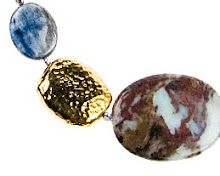
I really can't say enough about the importance of organizing one's supplies, like sterling silver findings. There are two different categories of organization: physical organization, and informational organization. And I'd like to touch on both and tell you a bit from personal experience, and invite you to send me your thoughts, personal solutions that you'd like to share with others, and tips on how to improve our system at Stones and Findings . Perhaps I'll write an update on our progress and some of your comments later on.
Sterling Silver Findings - Physical Organization
Physical organization mantra: a place for everything, and everything in its place . This is especially tricky with you have hundreds of different sterling silver findings, and some as small as 2mm. I'm not tidy by nature, but I will make the effort and when it takes me more than 3 minutes to find something on my desk, I take it as a higher sign that I need to do some cleaning. The worst organizer I met was a jewellery designer I had hired fresh from OCA (the prestigious Ontario College of Art). On her first full day of design work after orientation, she took jewellery findings out of bins and spread them all out on the large table. As I walked past many times throughout that day, I become increasingly alarmed by the build up of beads and sterling silver findings. When it came time for cleanup, company rule of 30 minutes before leaving for home, she had built up at least 2 litres in volume of tiny beads and pearls , all completely mixed. She asked if it was okay to leave it. The answer was a curt no, of course. She told me that one of her professors at the College was like this and that was how he functioned. She was young and so, I thought I'd do her the favour of not softening the edges of truth. I looked at her work for the day and I told her that she should try to emulate the professor's creative artistry and not just the mess. It wasn't long before I had to let her go. Jewellery really wasn't her forte, and her messiness was dragging everyone else down. Artistic talent is never a valid excuse for sloppy inefficiency.
On the other end of the mess meter was my experience on a Royal Caribbean cruise ship last Christmas. Occupancy was at its maximum, however, I never felt crowded, except in our cabin, with my kids' toys and clothes strewn everywhere. On the ship, every single wall panel had shallow shelving behind it, it seemed. These places held things like extra tea bags to napkins. Everything had a built-in place for it and the staff did a great job putting things back. I was really inspired and realized we have a long way to go and there are many exciting opportunities for improvement. Just remember that the time spent searching for things is money.
There are many simple things you can do to improve physical organization of your sterling silver components or jewellery business:
- For those designing with fewer sterling silver components , and jewellery beads or with lower budget, simple tackle boxes and food jars can go a long way. Food jars are bulky and you lose some room because they're round, but it's better than nothing and they usually come free. Canadian Tire has the best selection of tackle or sewing kit boxes
- Use Avery labels to label everything, including cost and supplier, if you don't mind others knowing
- If you're taking things out of their places to design, pour them out onto little saucers instead of building up a massive pool
- We've since made many strides in improving the organization of sterling silver findings in our shelves, with proper labelling and location. More can be done and I invite you to let us know how.
Feel free to click here and read on about Informational Organization of Sterling Silver Findings and Jewellery Supplies .

























